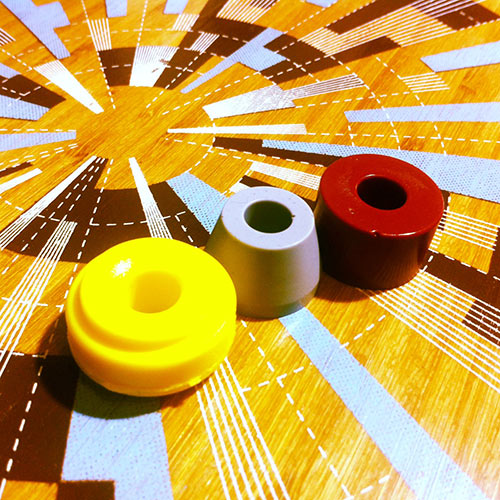Nothing in the world of longboard tech has a greater effect for the lowest out of pocket cost than a longboard bushing. These little nuggets of urethane come in all sorts of shapes, hardnesses and formulas that can drastically impact the way your board turns and responds to the force you inflict upon it. Cue your inner Muwhahahah and read on to dominate and conqour the bush(ing).
how do bushings work?
When you lean into a turn you pushing force down on what is known as the pivot axis of the truck. The main job of those little nipple bushes is to control how much the hanger of the truck (which holds the axis that the wheels are mounted on) should actually move (turn) per the amount of force you are putting into it. So keep this force to lean concept in mind as we explore hardness, shape and rebound. Also remember that the combination of these three properties of the bushing all work togther to factor into the overall performance, not any unique one.
bushing hardness
The hardness or durometer rating of a bushing is the most common spec to choose from when choosing longboard bushings. You’ll find commonly find ratings from 73a-101a on the durometer scale. The lower the number the softer the bushing. A softer bushing is going to have softer response and flex under pressure much easier giving the ride a looser feel good for smooth turns and carving. A harder bushing will have a more rigid and stable flex giving the ride a tighter feel good for sharp turns, stability and quick response.
 bushing shape
bushing shape
(barrel . cone . stepped . dbl stepped . hourglass)
Different shapes have different amounts of polyurethane and different angles of polyurethane that directly affect how much lean you get per the amount of force against it. Keeping the amount of force constant, more lean would result in a smoother feeling ride where as less lean would feel more rigid. The following is a breakdown of general bushing shapes in order from more lean per force to less lean per force.
barrel
A barrel shape contains the most polyurethane so it takes more force for it to give into your turns. So you would want a barrel shape bushing if you are looking for a more rigid/responsive feel during carves.
cone
A cone shape contains the least amount of polyurethane across all of the shapes. The result is the least amount of resistance and quicker turning capability than all the other shapes.
stepped cone
A stepped cone bushing is similar to a cone but fits more snug into place inside the truck setting providing a little more resistance for more control.
double stepped
A double stepped shaped bushing is similar to a barell but with extra polyurethane in the center area for extra stability in turns. Often used in downhill setups to control drifting at high speeds.
hourglass
Similar to the cone but the extra polyurethane along the top does not allow the bushing to distort as much. So more resistance is absorbed and the truck has a slightly stiffer feel.
rebound
When you make a hard turn or cave the bushing will compress under the force you apply so the hanger of truck can change angle to initiate your turn. Rebound is the uncompressing of your bushing and return to its center state after a turn. Higher quality bushings will have higher rebound and ultimately be more stable and responsive because of that. Higher quality bushings also prove to last longer as rebound diminishes over time.
